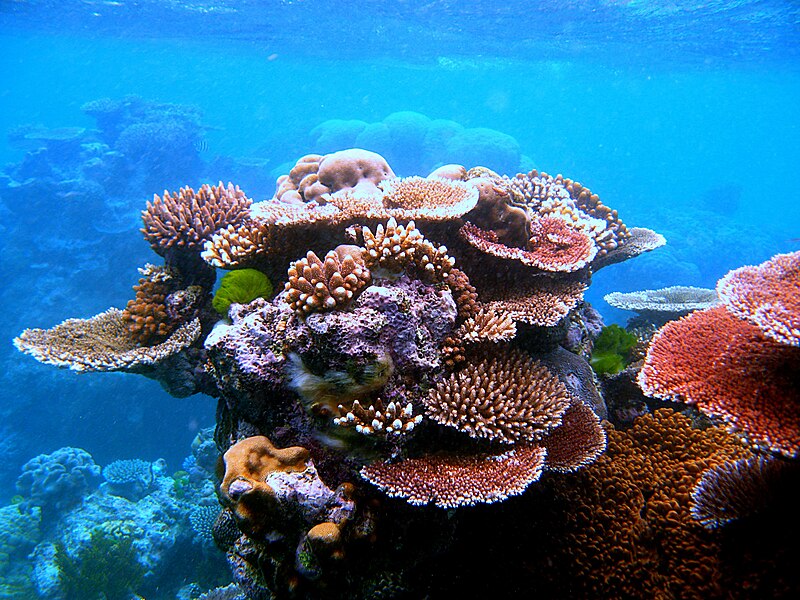- ACS Community
- :
- Science
- :
- Green Chemistry
- :
- Green Chemistry Institute
- :
- GCI Nexus Blog
- :
- Chemistry and Coral Reefs – Bleaching and Greening
Chemistry and Coral Reefs – Bleaching and Greening
- Subscribe to RSS Feed
- Bookmark
- Subscribe
- Printer Friendly Page
- Report Inappropriate Content
By Alex Co, undergrad chemistry major at Yale University
To see some of the planet’s most picturesque scenery, you will have to take a trip below sea level. Often called “rainforests of the sea”, coral reefs are among the Earth’s most diverse ecosystems. This video from National Geographic provides a beautiful introduction to the Great Barrier Reef, the world's largest single structure made by living organisms.
Despite covering less than 0.1% of the ocean’s surface, coral reefs are home to 25% of all marine species, where 30 of 34 known animal phyla are present. They are the basis for 10% of the world’s diet. And while scientists previously looked toward plants for medicinally potent compounds, coral reefs are now receiving much attention as an untapped pharmaceutical resource. It is therefore of the utmost importance that we protect coral reefs, both to prevent extinction and discover new medicines.

A variety of corals on Flynn Reef, part of the Great Barrier Reef. From Wikipedia.
Coral reefs mainly consist of shells of aragonite, one of two naturally occurring crystalline forms of calcium carbonate (CaCO3). The corals themselves secrete these shells while maintaining a symbiotic relationship with small algae called zooxanthellae that live on the surface of the coral and give them their vibrant color.
Unfortunately, that vibrant color may be in danger due to environmental changes. The phenomenon of coral bleaching is receiving more attention as the problem worsens. Bleaching occurs through expulsion of the zooxanthellae or loss of its algal pigmentation. When coral and zooxanthellae cannot maintain their symbiotic relationship, corals may expel the zooxanthellae, leading to a whiter and “bleached” appearance and inability to sustain their symbiosis. Even though an estimated 25% of coral reefs have already disappeared and two-thirds of all coral ree..., a 2010 Yale University study showed that about three-quarters of Americans had not heard of coral bleaching or ocean acidification.

Many causes of bleaching are anthropogenic, either directly or indirectly. Some are as simple as sunscreen use. It is estimated that 4,000 to 6,000 metric tons of sunscreen annually wash off beach goers. There are both chemical and physical sun-blocking agents in commercial sunscreens, but the most harmful compounds to zooxanthellae are butylparaben, octinoxate, benzophenone-3, and 4-methylbenzilydene camphor.
These four compounds among the many ingredients in sunscreens are highlighted in a paper by Danovaro et al. (2008) from the Polytechnic University of the Marche in Ancona, Italy. Danovaro and his team obtained coral reef samples from around the world and tested the effects of various sunscreens and their ingredients. They found that these four compounds in particular had the most adverse bleaching effects. It turns out that they awaken dormant viruses within the zooxanthellae and induces their lytic cycle. These viruses replicate until their algae hosts explode, causing them to die off and induce bleaching of the coral. Since preventing the use of sunscreen would be a health hazard, some sunscreen manufacturers now produce “reef-safe” sunscreens as an alternative. These sunscreens are green in a number of ways – most do not contain the four toxic ingredients listed above. Others contain biodegradable materials while some utilize less harmful ingredients such as zinc oxide and titanium dioxide. In this way, people maintain their accustomed lifestyles without harming the vast coral reefs of the oceans.
Another chemical precursor to the bleaching of our coral reefs is the process of cyanide fishing. In this highly profitable enterprise, fishers crush sodium cyanide tablets and dissolve them in salt water. They then spray this solution at fish that dwell around coral reefs. The solution temporarily stuns the fish, which allows the fishers to catch them. If the fish dart back within the entanglement of the coral reef in attempts to hide, fishers ruthlessly hammer away at the coral until they obtain the stunned fish. While illegal in nearly every Indo-Pacific country, high premiums for live fish, which are considered delicacies in restaurants, drive the continued growth of this business that is now worth some $1 billion annually.
Unfortunately, cyanide is extremely lethal for the zooxanthellae that reside on the nearby coral reefs as a respiratory poison. The cyanide ion has an extremely high affinity for the ferric heme form of cytochrome c oxidase, also known as Complex IV and part of the electron transport chain in oxidative phosphorylation. In fact, it binds more strongly than does oxygen, which prevents the reduction of oxygen, halting cellular respiration and eventually causing death of the zooxanthellae by histotoxic hypoxia. And not only that, cyanide also inhibits photosynthesis of the zooxanthellae in two ways: it forms a stable complex with RuBisCo (ribulose-1,5-bisphosphate carboxylase/oxygenase), and it inhibits oxidation of plastoquinone-oxidoreductase.

While completely ending cyanide fishing, for both the fish and the reefs’ sake, would be ideal, that would require a gradual shift in economy and the culture of consumerism. Instead, recent efforts to combat the harm of cyanide fishing include using fine-mesh barrier nets instead of harmful sodium cyanide solutions. And if the industry must continue, some trades and institutions are finding alternative anesthetics that are equally as effective in stunning the fish but do not pose any harm to the surrounding coral reefs. Most of them are more or less still harmful to the zooxanthellae, but a bit less so, which is a step in the right direction. Clove oil, containing the main active ingredient of the phenylpropanoid eugenol, seems like a promising alternative at this time.

From: http://en.wikipedia.org/wiki/Eugenol
A study by Boyer et al. (2009) showed that at solution concentrations below 7% of clove oil/water, there were no demonstrable effects of bleaching or mortality of the tested coral fragments. Industry usage has indicated that solutions of 14% clove oil or less are still effective in stunning coral reef fish. Ultimately, the problems surrounding cyanide fishing are numerous, but some solutions seem promising.
Perhaps one of the most extensive anthropogenic danger to coral reefs is the increased carbon dioxide levels in seawater. Through the ongoing debates about greenhouse gases, the general consensus is that the level of carbon dioxide in the atmosphere is on the rise. Some of that carbon dioxide ends up dissolving in sea water, forming carbonic acid and acidifying the sea water. About 20% of atmospheric carbon dioxide is absorbed by ocean waters.

http://www.coralscience.org/main/articles/biochemistry-2/how-reefs-grow
The second half of this pictorial equilibrium relates to the backbone of coral reefs, which are composed of aragonite, one of the crystalline forms of CaCO3. Ca2+ and CO32- ions are excreted by the calicoblastic layer of the corals, which lie of the underside of the polyps that both propagate all over the surface of the coral backbone as well as contain the symbiotic zooxanthellae. At the high pH levels maintained by the calicoblastic fluid (around 9.3 during the day and 8 at night, convergent with photosynthesis cycles), CaCO3 cannot dissolve properly and precipitates as the extensive aragonite shells of the coral backbone. Without this high pH level, coral skeletons dissolve quickly and more carbonate ions turn into bicarbonate ions as the pH level decreases. The increase in H+ concentration causes the decrease in pH as well as shifts the equilibrium toward the carbonate side. But at the lowered pH, CaCO3 dissolves and therefore does not form aragonite, breaking apart the coral skeleton. This has led to a decline in coral calcification seen all over the world’s coral reefs. Without the proper support for the symbiotic relationship for the zooxanthellae, they leave the coral, which again leads to the rampant bleaching that we see.
Current efforts to reverse bleaching include the extraction of carbonic acid as carbon dioxide from sea water to produce synthetic fuels. This process is carbon negative over time, and based on the energy requirements is expected to cost about $50 per ton of CO2. Another proposed solution is iron fertilization of the ocean, which stimulates photosynthesis in phytoplankton causing them to consume more of the CO2 in the sea water. The process is not perfect, however - Cao and Caldeira (2010) believe that iron fertilization could mitigate acidification closer to the surface at the cost of increasing deep ocean acidification.
Green chemistry may hold the solution to some of these concerns. It is a growing area of the chemistry discipline that encourages "the design of chemical products and processes that reduce or eliminate the use or generation of hazardous substances," according to the Environmental Protection Agency. Chemicals often receive a bad reputation that is not entirely deserved. Moreover, a great number of chemists are working to develop alternatives that are just as effective as our standard compounds but are less harmful to coral reefs, among many other things.
Ultimately, it seems chemicals receive a bad reputation for the harm they cause to coral reefs. But in the field of green chemistry, we are changing that for good. "Father of Green Chemistry" Paul Anastas, the director of Yale's Center for Green Chemistry and Green Engineering and former Science Advisor to the Environmental Protection Agency recalls a meeting filled with angry Louisianans in the wake of the BP oil spill in the Gulf of Mexic.... That is just one moment that resonates with him as he continually challenges the deeply-rooted assumption that "'chemical' has to be a dirty word". Despite the harm some chemicals may cause in coral reefs across our oceans, there are just as many being developed that work just as well or even better and do not endanger these precious ecological habitats. Other work at The Center for Green Chemistry and Green Engineering at Yale includes developing a system that tests the toxicity of chemicals before they are designed, a project spearheaded by Dr. Julie Zimmerman and her team of researchers. The examples highlighted here are only a few of the incredible advances of green chemistry. It is an exciting time to join this field that works toward discovering new and safer alternative chemicals and processes every day.
This blog was co-published in the ACS Undergraduate blog, Reactions
“The Nexus Blog” is a sister publication of “The Nexus” newsletter. To sign up for the newsletter, please email gci@acs.org, or if you have an ACS ID, login to your email preferences and select “The Nexus” to subscribe.
To read other posts, go to Green Chemistry: The Nexus Blog home.




